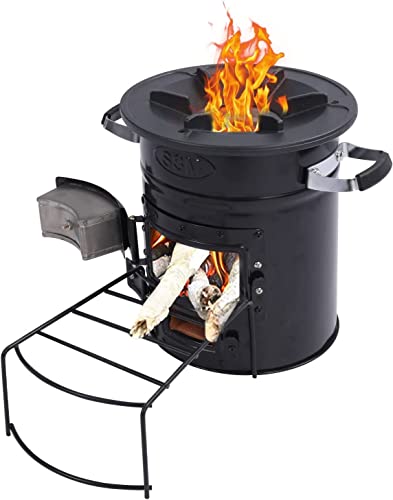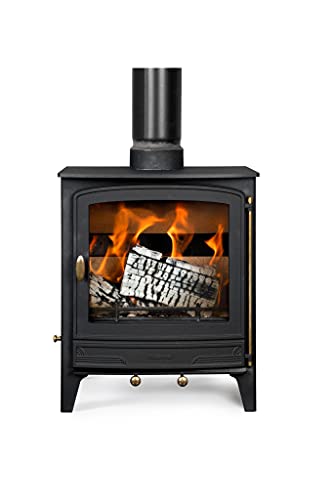Woodburning Stove Tools To Ease Your Daily Life Woodburning Stove Tric…
페이지 정보

본문
 How to Properly Operate a woodburning stove (https://djurhuus-Henriksen-2.federatedjournals.com)
How to Properly Operate a woodburning stove (https://djurhuus-Henriksen-2.federatedjournals.com)Wood stoves are a fantastic option to heat your home. They're also cheap. Smoke from wood stoves can be hazardous to your health. It's important to understand how these appliances function and how they operate.
A lot of modern stoves rely on secondary combustion or catalytic to limit their emissions. Older stoves and open flames release large wood burning stove for sale amounts of particulates.
The firebox
The firebox is the heart of any fireplace system. It's where you create a fire to heat your home and provide ambiance. It's a simple concept, but there are many important details that must be accounted for to keep your wood burning stove safe and efficient.
The firebox is described as an open-air combustion chamber with walls and a lid. Most fireplaces have either a prefabricated metal or the masonry firebox. The type of box you choose will depend on your preferences and the kind of fireplace you have.
Most fireplaces with wood burning make use of a constant flow of air to create the flame and burn fuel. Fresh air is pumped into the stove through dampers that can be adjusted inside the doors. This lets the fuel burn efficiently and helps reduce the toxic gases produced by incomplete or unburnt combustion. The exhaust gases will then be dragged up the chimney and safely away from your home.
Modern stoves with catalytic second combustion use a special catalyst that allows unburned gases to be reburned to produce additional warmth. This creates a cleaner and less polluting fume than traditional corner wood heater stoves without secondary combustion. Modern wood stoves that are not catalytic are available however they are usually less efficient than those with catalytic second combustion.
Some small wood burning stove indoor-burning stoves have a backboiler that can be used to heat water in addition to space heating. These stoves are referred to as "hybrids" or "combination". They have been in use since the early 20th century.
Wood burning stoves should only be burned with seasoned small wood stove for shed. Freshly cut wood (green) has a high water content. This could lead to low flue temperatures, as well as an excessive accumulation of creosote in the chimney. This can lead to chimney fires that can cause damage to your stove and could be harmful to the health of your family members.
If you are looking for an expert who can examine your wood-burning stove or do repairs to your firebox, be sure the chimney technician you choose is certified by the CSIA certification and has reviews from customers on their website. It's also important to inquire about their pricing and what is the type of work they can do.
The pipe for ventilation
Ventilation is a must for wood stoves in order to remove smoke and keep the home safe and warm. Ventilation is required to remove carbon monoxide and nitrogen dioxide from the combustion process. It also helps reduce air pollution and heat loss to the outdoors. Gas, wood and pellet stoves have different requirements for venting to accommodate the ways they function. Maintaining the stove's ventilation system annually is critical to ensure safety and efficiency.
The ventilation system is made up of the firebox and the ventilation pipe. The chimney and the ventilation pipe work together to create draft, bringing smoke from the stove through the fireplace to outside air. Draft is created by the variation in temperature and density between hot wood smoke and cold outside air. The more hot the temperature, the more smoke can rise through the ventilation pipe and chimney.
Modern wood stoves have been certified as low-emission units by EPA. They produce far less pollutants than older models that contribute to global warming and other environmental issues. Most modern stoves have built-in pollution control systems to limit the amount of emissions, while ensuring that they are burned efficiently.
Older stoves that have open flues create more carbon dioxide. This is a toxic, toxic gas and it must not escape into your home. Carbon monoxide can be a source when the chimney is dirty or there is inadequate ventilation. Installing carbon monoxide alarms in your home is therefore crucial.
Measure the distance between the chimney's opening in the wall or ceiling and the place where the wood stove is on the floor. Multiply this distance by two to calculate the minimum length of stovepipe you require. You can choose a single-wall or double-wall stovepipes however, you must ensure adequate clearance from the combustibles.
When the stove is lit for the first time, adjust the air vent until a stable flame has been created and the combustion process is stable. It is also a good idea to avoid using wood briquettes in the stove, since they are not logs and can contain volatile chemicals that could cause the air vent to fail and create a dangerous situation.
The chimney
The chimney is a complex system which requires attention and care. The chimney is comprised of many important components that are essential to the safety and efficiency of your stove.
The firebox, the ventilation pipe and chimney work together to release the combustion gases produced by your woodburning stove the outside. This process is critical in preventing harmful emissions and reducing carbon dioxide levels within your home. To achieve this the chimney and flue should be hot enough to move the gases from the fireplace without cooling. This can be achieved by using a woodburning stove that has an extremely high heat output, and by regularly adding new logs to the fire.
Most modern woodburning stoves are designed to operate with a chimney that's taller than older systems in order to create a more draft effect. This could cause problems if your chimney height exceeds the maximum for your location. In this scenario, the chimney could compete with the stack of your house for airflow, causing gases to cool down before leaving. This can result in a decrease in the flow of gas, and a buildup on creosote.
The most common error homeowners make is to open the fireplace door and close it frequently. This can negatively affect the combustion. It is essential to keep the door shut as much as possible and only open it when you need to add more firewood or ash. The door should not be opened for too long. This lets hot air from the stove to escape, making the logs cooler and less likely to light.
Another common mistake that people make is to use different kinds of combustibles inside their woodburning stoves. This can result in more emissions or even a chimney fire. The fact is that woodburning stoves are designed and optimised to burn firewood and not other types of combustibles.
The flu
A woodburning stove requires a properly size flue to permit adequate draft development and air flow. Typically, the dimensions of the flue has to be at least 25 percent larger than the stove pipe (which connects the stove to the chimney) to allow enough space for smoke circulation. A wood stove must be set on a non-combustible hearth that has a clear space in front of the fireplace opening.
Modern stoves have catalytic combustion systems that reduces the amount harmful byproducts that get released into the chimney. This feature is also able to increase the efficiency of best wood burner stoves by burning a fire that generates more heat and less polluting. However, using other types of combustibles, such as coal, can cause issues, including lower efficiency and greater emissions.
When you are burning wood in a fireplace or stove it is essential to use dried or seasoned wood. If the wood isn't properly seasoned or dried, it will release a large amount of water vapor into your chimney. This could result in low flue temperatures and even a chimney fire.
A professional can also help you avoid the possibility of a chimney fire by regularly inspecting and cleaning the flue system. This includes the stovepipe, the chimney and the chimney itself.
A soiled stove or flue system may lead to a poor draft in your chimney, which could cause carbon monoxide to build up within your home. This can be dangerous for your family and should never be allowed to occur.
A good rule of thumb is to have a professional chimney sweep sweep your stove and chimney once per year. This will also help to keep your chimney and stove operating efficiently.

- 이전글14 Cartoons About Outdoor Wood Burner That'll Brighten Your Day 25.01.29
- 다음글The Three Greatest Moments In Best Robot Vacuum History 25.01.29
댓글목록
등록된 댓글이 없습니다.


